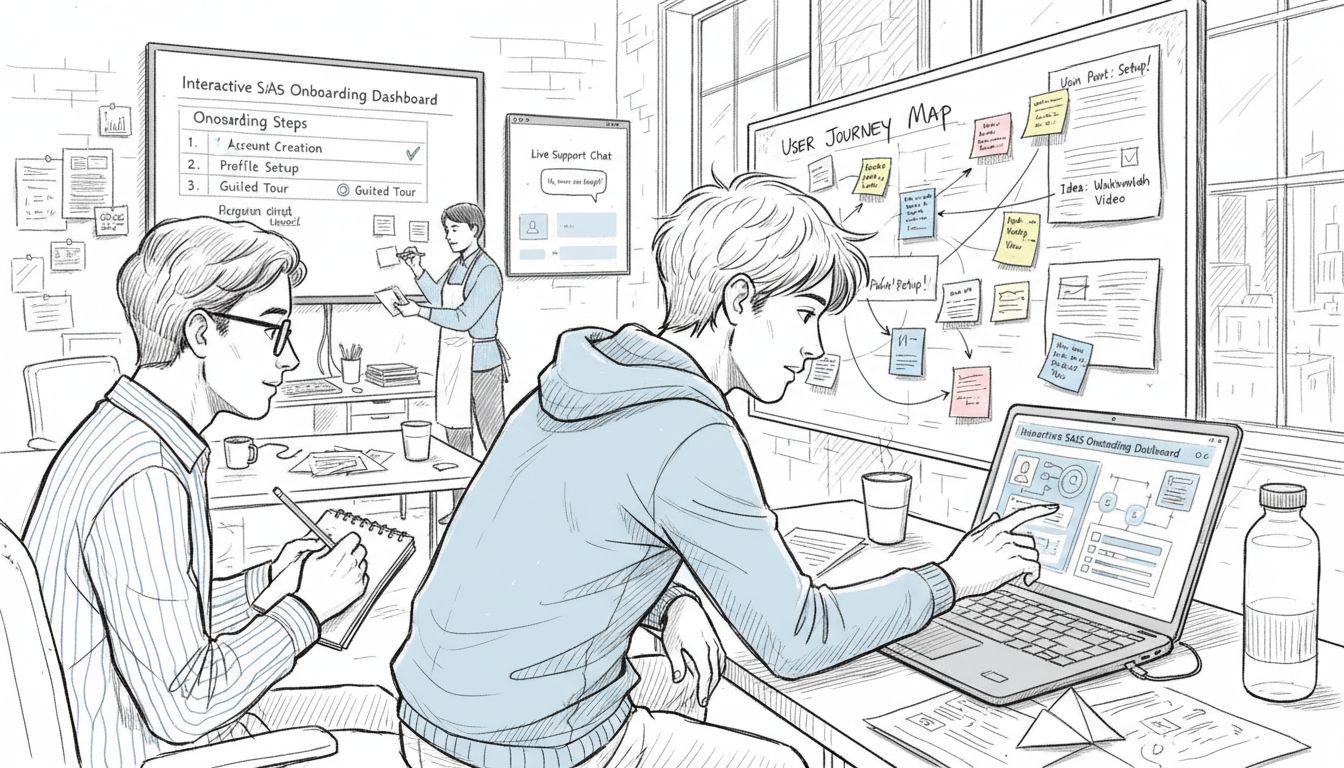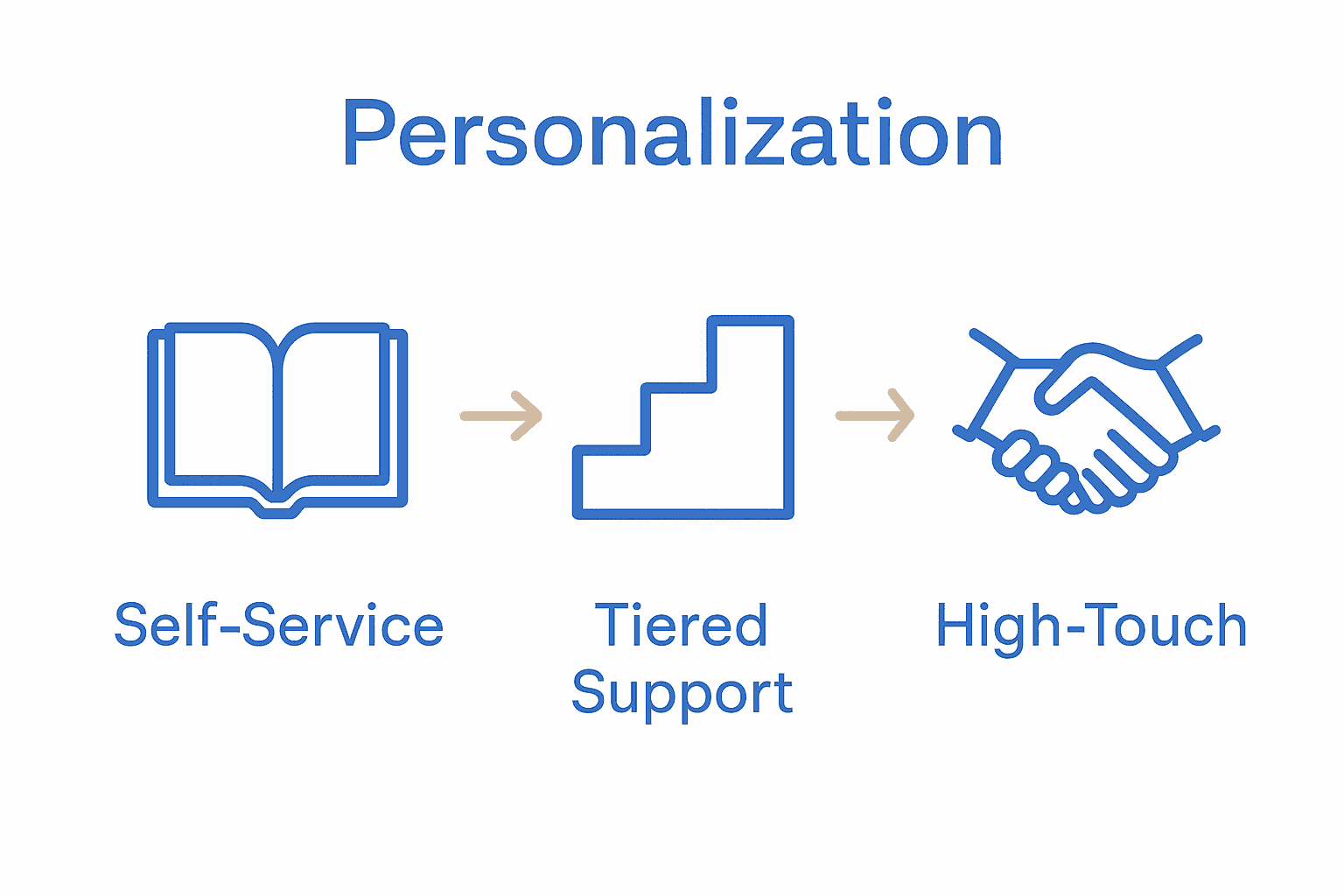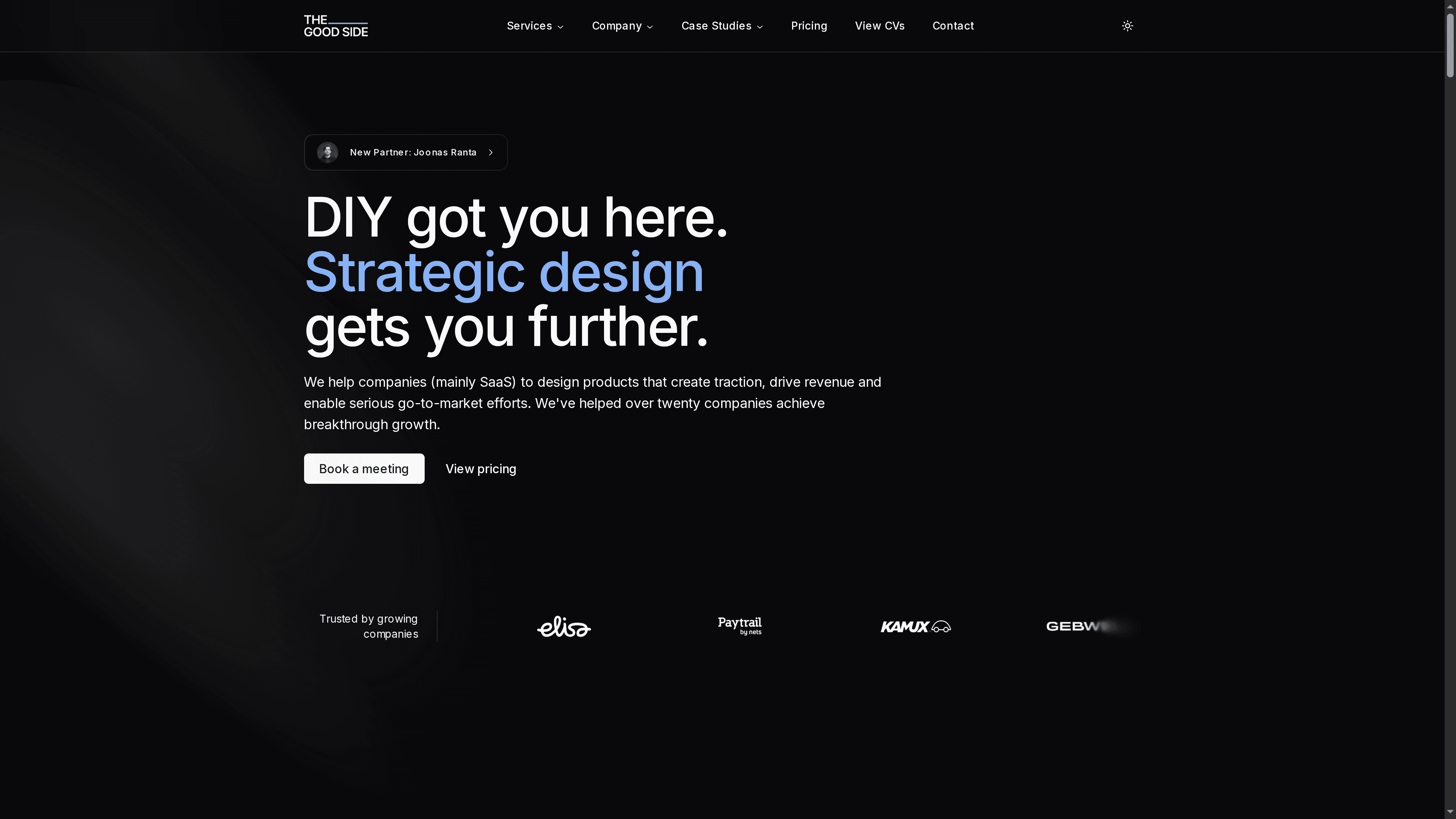Service Design Explained: Building Cohesive SaaS Experiences
Comprehensive guide to service design for SaaS: definitions, core principles, process steps, real-world SaaS use cases, and key benefits for teams.

Nearly 80 percent of organizations struggle to align technology, user needs, and business goals when designing digital services. In a world where seamless experiences define brand loyalty, service design stands out by turning complex processes into intuitive journeys that truly work for everyone involved. Discover how understanding the fundamentals of service design leads to powerful solutions that meet needs on every side of the equation.
Table of Contents
- What Is Service Design? Core Concepts Defined
- Types of Service Design in SaaS Contexts
- Key Principles and Process Steps in Service Design
- Service Design Applications for SaaS Products
- Common Challenges and Mistakes to Avoid
Key Takeaways
| Point | Details |
|---|---|
| User-Centered Approach | Service design prioritizes understanding user needs to create intuitive experiences that address both user and business objectives. |
| Collaborative Design Process | Involving cross-disciplinary stakeholders is essential for developing comprehensive service solutions that enhance user interactions. |
| Continuous Iteration | Regular testing and refinement of service designs allow businesses to adapt and improve based on real user feedback. |
| Holistic Experience Focus | Effective service design must consider the entire user journey across various touchpoints to ensure a seamless, cohesive experience. |
What Is Service Design? Core Concepts Defined
Service design is a strategic approach to creating exceptional digital experiences that seamlessly connect users with services, technology, and organizational goals. At its core, service design transforms complex interactions into intuitive, meaningful journeys that solve real problems for both users and businesses. According to ServiceDesign.college, this discipline is fundamentally about “designing and improving service quality by effectively meeting the needs of both users and providers.”
The methodology goes far beyond traditional design thinking by taking a holistic view of how users interact with services. Key principles include:
- User-Centeredness: Placing human needs and experiences at the center of design decisions
- Collaborative Approach: Involving stakeholders from multiple disciplines in the design process
- Comprehensive Mapping: Creating detailed visualizations of entire user journeys
- Continuous Iteration: Regularly testing and refining service experiences
Understanding service design requires recognizing that modern digital experiences are interconnected ecosystems. Wikipedia highlights that effective service design focuses on creating experiences that are “intuitive, collaborative, and comprehensive” by integrating five core principles: user-centeredness, co-creation, sequencing, evidencing, and holistic thinking. This means designers must think beyond individual touchpoints to consider the entire end-to-end experience.
For SaaS companies specifically, service design becomes a critical strategic tool for differentiating products in increasingly competitive markets. It transforms complex software interactions into seamless, engaging experiences that not only solve user problems but anticipate their needs before they arise. Check out our comprehensive guide on the role of service designers in SaaS to dive deeper into how these professionals create exceptional digital experiences.

Types of Service Design in SaaS Contexts
Service design in SaaS environments isn’t a one-size-fits-all approach, but rather a nuanced strategy that adapts to different organizational needs and user experiences. Givainc highlights that SaaS service design models typically range from self-service resources to highly personalized support structures, demonstrating the flexibility required in modern software experiences.
The primary types of service design in SaaS can be categorized into several key models:
- Self-Service Design: Empowering users with knowledge bases, tutorials, and automated support channels
- Tiered Support Design: Structured support levels with escalating complexity and expertise
- High-Touch Design: Personalized service with dedicated customer success managers
- Proactive Engagement Design: Anticipatory support that identifies and resolves potential issues before they impact users
Nilebits reveals another critical dimension of service design through architectural perspectives. SaaS applications can be designed across three primary architectural models: single-instance (dedicated resources per customer), multi-instance (shared infrastructure with separate databases), and multi-tenant (shared application and database). Each architecture profoundly impacts the service design approach, user experience, and scalability.

Ultimately, effective service design in SaaS requires a deep understanding of user needs, technological constraints, and business objectives. For teams looking to dive deeper into design strategies, our guide on SaaS design types offers comprehensive insights into creating exceptional digital experiences.
Key Principles and Process Steps in Service Design
Service design is a structured yet dynamic approach that transforms complex user interactions into seamless, meaningful experiences. Wikipedia outlines five foundational principles that serve as a strategic framework: user-centeredness, co-creation, sequencing, evidencing, and holistic thinking. These principles aren’t just theoretical concepts but practical guidelines that drive exceptional service experiences.
The core process steps in service design typically involve:
- Research and Discovery: Understanding user needs, pain points, and contextual experiences
- Stakeholder Mapping: Identifying and engaging all individuals impacted by the service
- Journey Visualization: Creating detailed maps of user interactions and emotional touchpoints
- Prototype Development: Building initial service models for testing and validation
- Iterative Refinement: Continuously improving the service based on user feedback
Icore-ltd emphasizes that effective service design goes beyond aesthetic considerations, focusing on gathering both functional and non-functional requirements while aligning them with broader business objectives. This means translating user needs into concrete design specifications that not only satisfy customer expectations but also drive organizational efficiency.
For SaaS teams looking to implement robust service design practices, understanding these principles and processes is crucial. To gain deeper insights into how service designers approach complex challenges, check out our comprehensive guide on the role of service designers in creating transformative digital experiences.
Service Design Applications for SaaS Products
Service design transcends traditional product development by creating comprehensive, user-centric experiences that address complex software interaction challenges. Nilebits reveals that SaaS products fundamentally differ in their architectural approaches, with three primary models influencing service design: single-instance (dedicated resources), multi-instance (shared infrastructure), and multi-tenant (shared application and database) architectures.
Key applications of service design in SaaS products include:
- User Onboarding: Crafting intuitive initial user experiences
- Feature Personalization: Adapting interfaces to individual user needs
- Customer Support Integration: Seamlessly embedding support mechanisms
- Interaction Flow Optimization: Streamlining user journeys across touchpoints
- Scalable Experience Design: Creating flexible experiences that grow with user complexity
Givainc emphasizes that effective service design in SaaS goes beyond technical implementation, focusing on creating nuanced support models. These models range from automated self-service channels to high-touch, personalized support structures that anticipate and resolve user challenges proactively.
To dive deeper into how top SaaS teams implement these strategies, explore our product design workflow guide that breaks down the intricate process of transforming complex software interactions into seamless, compelling user experiences.
Common Challenges and Mistakes to Avoid
Service design in SaaS environments is fraught with potential pitfalls that can derail user experiences and organizational effectiveness. Icore-ltd highlights a critical mistake many organizations make: focusing exclusively on technical requirements while overlooking the holistic user experience. This narrow perspective can create technically functional but fundamentally unusable services that fail to meet genuine user needs.
Key challenges and mistakes to avoid include:
- Overlooking User Context: Designing solutions without deep user understanding
- Rigid Support Structures: Creating inflexible interaction models
- Technical Tunnel Vision: Prioritizing features over actual user problems
- Neglecting Emotional Journey: Ignoring the psychological aspects of user interactions
- Inconsistent Experience Design: Failing to maintain coherence across different touchpoints
Givainc emphasizes that truly effective service design requires adaptable support models. Rigid, one-size-fits-all approaches inevitably lead to user frustration and potential churn. Successful SaaS products must create flexible, customer-centric support structures that can dynamically respond to evolving user requirements.
To develop more nuanced service design strategies, consider exploring our comprehensive guide on service designers’ roles, which provides deeper insights into creating exceptional, user-focused digital experiences.
Unlock Seamless SaaS Experiences with Expert Service Design Support
The article highlights the critical challenge of turning complex interactions into intuitive, user-centered journeys that truly resonate with customers. If you have struggled with disconnected user journeys, rigid support systems, or unclear product positioning, you are not alone. Service design is about holistically mapping user needs while balancing technological and business goals to create cohesive, scalable SaaS experiences.
Key pain points like inflexible service models and overlooked emotional journeys can lead to user frustration and churn. The good news is you do not have to navigate these intricate challenges alone. At The Good Side Oy, we specialize in bridging these exact gaps by providing strategic design partnerships tailored for SaaS companies. Our senior designers use proven methods from user research to end-to-end journey optimization, helping you transform fragmented interactions into clear, engaging, and revenue-driving experiences.
Ready to stop wasting time on disjointed interfaces and start delivering unified SaaS products that drive activation and growth?
Discover how our flexible services from consulting to fully embedded design can fast-track your product’s success.

Visit The Good Side to start with a free design audit and experience fast integration with top SaaS design talent. Learn more about how our role of service designers can elevate your user journeys and boost your outcomes. For an in-depth look at design approaches, explore our guide on the types of SaaS design. Your cohesive, high-performing SaaS experience starts here.
Frequently Asked Questions
What is service design in the context of SaaS?
Service design in SaaS refers to the strategic approach used to create exceptional user experiences that effectively connect users with software services. It emphasizes understanding user needs, mapping user journeys, and ensuring seamless interactions with the product.
How does service design improve user experiences in SaaS?
Service design improves user experiences by focusing on user-centeredness, co-creation, and continuous iteration. By mapping out user journeys and anticipating their needs, service design creates intuitive and engaging software interactions that solve real user problems.
What are the key principles of service design?
The key principles of service design include user-centeredness, co-creation, sequencing, evidencing, and holistic thinking. These principles help guide the design process to ensure that user experiences are comprehensive and meaningful.
What common mistakes should be avoided in SaaS service design?
Common mistakes in SaaS service design include overlooking user context, creating rigid support structures, focusing solely on technical features, neglecting emotional aspects of user interactions, and failing to maintain consistency across different touchpoints.